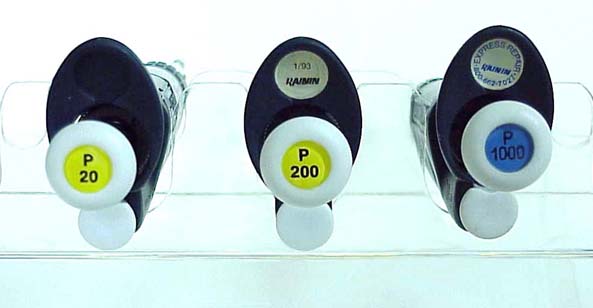
(Image depicts the three calibers of pipetman
available at Middlebury College)
Setting the Volume:
Click
here to view a video tutorial
The volume of liquid to be aspirated is set using the volumeter. The volumeter
consists of three number-dials, which are read from top (most significant
digit) to bottom (least significant digit). A marker is used to set exact
or intermediate volumes using the scale on the bottom dial. The dials
are colored either black or red to indication the position of the decimal
point, according to the model.
The volume is set by turning the thumbwheel or the push-button. The push-button
makes it easier and quicker to set volumes, especially when wearing gloves.
The thumb-wheel may be turned to slowly reach the required setting.
To obtain maximum accuracy when setting the volume, proceed as follows:
-when decreasing the volume setting, slowly reach the required setting,
making sure not to overshoot the mark.
-when increasing the volume setting, pass the required value by 1/3 of
a turn and then slowly decrease the volume to reach the volume, making
sure not to overshoot the mark.
*Note* It is important to remember to choose the smallest possible
pipetman for the volume desired for accuracy. For example, students wishing
to measure 10µl of fluid should use the P-20 as it gives the most
control.

Pipetting:
Click
here to view a general video tutorial
Click
here to view a video detailing the correct way to 3) aspirate the
liquid.
1) Fit a new tip.
2) Pre-rinse the tip.
• Some liquids (e.g. protein-containing solutions and organic solvents)
can leave a film of liquid on the inside the wall of the tip; pre-rinse
the tip to minimize any errors that may be related to this phenomenon.
3) Aspirate.
• Press the push-button to the first stop (this corresponds to the
set volume of liquid).
• Hold the pipette vertically and immerse the tip in the liquid.
• Release the push-button slowly and smoothly (to top) position
to aspirate the set volume of liquid.
• Wait one second; then withdraw the pipette-tip from the liquid.
• You may wipe any droplets away from the outside of the tip using
a medical wipe, however if you do so take care to avoid touching the tip’s
orifice.
4) Dispense.
• Place the end of the tip against the inside wall of the recipient
vessel.
• Press the push-button slowly and smoothly to the first stop.
• Wait at least a second; then press the push-button to the second
stop to expel any residual liquid from the tip.
• Keep the push-button pressed fully down and (while removing the
pipette) draw the tip along the inside surface of the vessel.
• Release the push-button, smoothly.
5) Eject the tip by pressing firmly on the tip ejector button.
|

